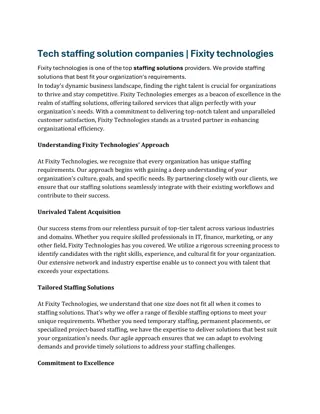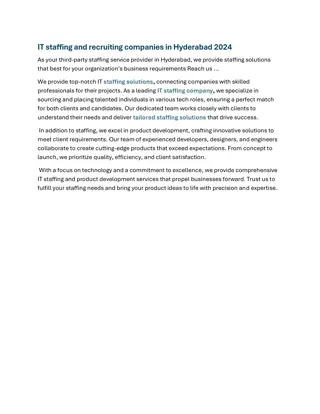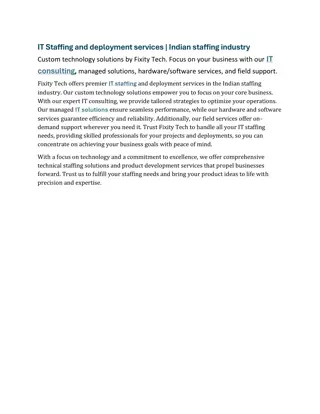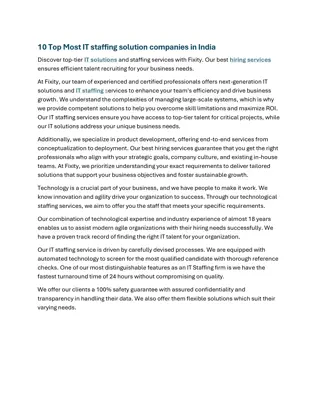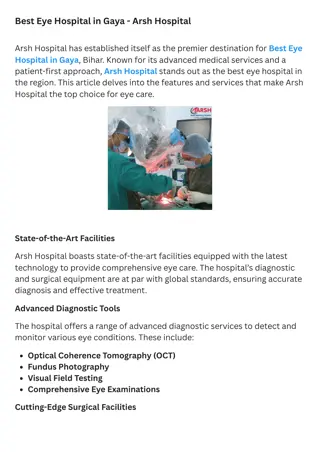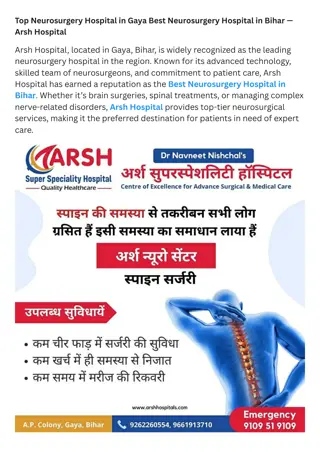Staffing and Infrastructure Guidelines for Hospital Pharmacies
Guidelines for determining the staff requirements and infrastructure setup of hospital pharmacies based on factors like bed strength, in-patient and out-patient numbers, and activities provided. Essential roles like chief pharmacist, registered pharmacists, assistants, and clerical staff are outlined. Space requirements for various pharmacy unit sections are specified, along with necessary equipment for compounding, dispensing, and manufacturing of drugs.
Download Presentation

Please find below an Image/Link to download the presentation.
The content on the website is provided AS IS for your information and personal use only. It may not be sold, licensed, or shared on other websites without obtaining consent from the author.If you encounter any issues during the download, it is possible that the publisher has removed the file from their server.
You are allowed to download the files provided on this website for personal or commercial use, subject to the condition that they are used lawfully. All files are the property of their respective owners.
The content on the website is provided AS IS for your information and personal use only. It may not be sold, licensed, or shared on other websites without obtaining consent from the author.
E N D
Presentation Transcript
PRESENTING BY PRIYA. K IV thPHARM. D JSS COLLEGE OF PHARMACY
STAFFS The staff requirement for a hospital pharmacy depends on Number of beds in the hospital Average number of in-patients and out-patients Activities of the unit Whether the pharmacy dispenses surgical and laboratory supplies also stocks and
GENERAL GUIDELINES FOR THE DETERMINATION OF STAFF OF PHARMACY 1 chief pharmacist 1 registered pharmacist for an average daily attendance of 60 patients with a minimum of 4 pharmacists for smaller hospitals Adequate no: of assistants, attendants and sweepers 1 typist cum clerk For manufacturing and formulation of drugs A deputy to the chief pharmacist designated as manufacturing pharmacist 1 analytical pharmacist
In general, hospitals having a bed strength of upto 50, 100, 200, 300 beds require 3, 5, 8 and 10 pharmacists respectively For large hospital 1 pharmacist should be appointed for every 133 patients
INFRASTRUCTURE SPACE Space requirement depends on the no: of beds, number and types of sections in pharmacy unit, no: and types of out patients and location of the hospital Dispensing department should not be less than 6 sq.metres for 1 pharmacist and additional 2 sq.metres for each additional pharmacist Amodern hospital pharmacy should provide
Waiting room i. ii. Office of the chief pharmacist iii. Office for clerk cum typist iv. In patient and out patient dispensing lab v. Manufacturing laboratary vi. Product formulation, control and research laboratory vii. Pharmacy store room viii.Alcohol and volatile liquids vault or room ix. Additional bulk storage facilities x. Radiopharmaceutical lab
AREA EQUIPMENT Compounding and dispensing unit Balance, beakers, bottles, tripot stand, water bath, book shelves, suppository moulds, funnels, glass Pharmacy store Cabinets, racks, refrigerator, exhaust fan, alcohol vault, equipment for packing and repacking of cases Equipment for manufacture of external preparations Mixing tanks, kettle, steam. Colloid mill, liquid filling equipment, storage tanks Equipment for the manufacture of internal/oral preparations Mixing and storage tanks, portable mixer, vacuum or gravity filter, bottle filling machine, water still Equipment for the manufacture of powders Disintegrator, mixer, stainless steel vessels, filling equipment, sifter, scoops Equipment for filling of hard gelatin capsules Mixing and blending equipment, capsule counters Equipment for the manufacture of pessaries and suppositories Mixing and pouring equipment, moulding equipment
WORKLOAD STATISTICS The federal government in 1952 provided job description for chief pharmacist, pharmacist and pharmacy helper Job summary of chief pharmacist : compounds and dispenses according to prescription written by physicians, dentists and other practitioners authorized by law to prescribe. Prepares and sterilizes injectable medication manufactured in hospital. Furnishes information concerning medications to physicians, interns and nurses. Plans, organizes and directs pharmacy policies and procedures in accordance with established policies of hospital. Implements decision of PTC of which he is a member. medicines and preparations
DETERMINING THE DEPARTMENTAL STAFF- PROFESSIONAL Is the department to serve in patients only? How many in patients? Is there to be any out patient service? How many out patient peer day? Is there to be a manufacturing section of the pharmacy? Is the pharmacy going to stock and dispense surgical and laboratory supplies?
DEPARTMENTAL ACTIVITY CHART pharmacy Dispensing manufacturing purchasing and statistics and inventory control reports teaching control outpatient inpatient research bulk medical and surgical supplies large vol. parenterals ward or floor stock small vol. parenterals alcohol surgical irrig. fluids narcotics allergic extracts
PHARMACEUTICAL SERVICES IN OUTPATIENT DEPARTMENT RX doctor RX pharmacist filling of prescription dispensed to patient Receipt of payment prescription filled Free cash charge regular RX narcotic RX file file
LOCATION Separate outpatient pharmacy minimum disturbance is caused to the inpatients and the routine working to the hospital and its pharmacy Easily accessible to the out patients LAYOUT provided with a prescription receiving window and a delivery window Waiting area
Patients can also be made familiar with family planning projects, general hygiene etc through display of wall posters RECOVERY AND SERVICE CHARGES arbitrary fee depending on dosage form and number of doses supplied Simple mark up procedure depending upon the cost of the drug Professional fee system
PF = COD + PROFIT COD = Total expenses Drug costs No: of medication order dispensed PREPACKING Demand for the product Type of containers and closure to be used Special labelling required Stability of the product and expiry date
PHARMACEUTICAL SERVICES IN IN-PATIENT DEPARTMENT LOCATION AND LAYOUT Separate in-patient pharmacy department Located in a place easily accessible to wards and free from disturbances as far as possible All sections of pharmacy should be continious These section should be in direct vertical relationship Modern hospitals, satellite pharmacies are operated
PERSONNEL BED STRENGTH PHARMACISTS 50 3 100 5 200 8 300 10 500 15 Overall charge of the in-patients unit should remain with the chief pharmacist





